THE ANATOMY OF A PARKWAY STRIP
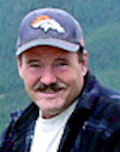
CyberSage (Jack)
THE BUS OR TROLLEY STOP
If you are fortunate enough to have a layout of the old bus or trolley stops in your city, you have literally found a treasure map, my friend. The parkways near these areas are prime for finding great old coins. I can just see someone trying to board for a ride and dropping change as they try to pay. No time to go looking for that dime that has rolled down the steps out of sight. Perhaps, the small child who is allowed to hold his or her own bus fare or trolley token has gotten a little careless, as children do, and dropped it in the grass where they where playing. Needless to say, you will do well in these areas.
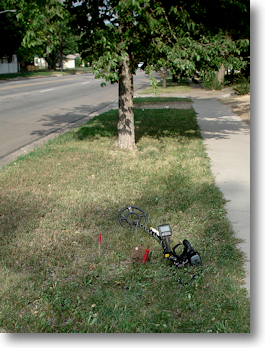
I didn't know it at the time, but this turned out to be an old bus stop. This small little area produced many nice wheat pennies and some 1950's silver. On a side note, I noticed as I hunted this area that some other detectorist had been there before me. I found several cut plugs in the grass as I hunted. Never say, "Hunted out".
Other sources for finding these key locations are oral histories from people who have grown up in the area and old pictures. Both of these items can be commonly found at the local library. Those old timers who come down the sidewalk on their daily walks are one of the greatest sources of information to be found. Next time they stop and ask you if you found anything, remember what I said about being friendly. Now would be a good time to put down the detector; show some finds; and strike up a conversation. Let them tell you about what used to be in the area. You will surely benefit!
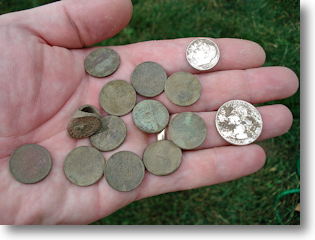
This is a good example of why knowing the local history of an area can be very beneficial to your treasure seeking ways. The museum in your town may have displays in place concerning the development of transit systems in your area. This is a popular subject matter with historians as well. Next time you find yourself in a dry spell, go for a visit to the museum and lose yourself in the past. When you find yourself having that first big "Ah-Ha" moment from your research paying off in great finds you will understand the value.
THE BOARDING HOUSE
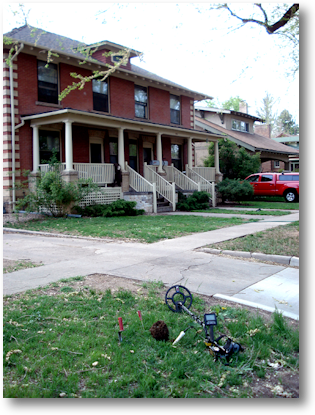
This location was more than obvious in its design. Many nice coins came out of the ground here. Pictured is the dig site of an 1889 Indian Head. As a side note, I have also pulled many nice rings from parkways that border current-day rental properties. The heavy traffic increases the loss factor.
Before the age of the duplexes and condos there where boarding houses. These were established living quarters where individuals were offered rooms, or sections of a house, to rent by the night, week, or month. These properties can stand out in their architecture and size. There will be multiple entrances, and perhaps even side entrances. The parkways in front of theses types of dwellings have seen more traffic from moving items in and out of the premises. If there is an old college in the neighborhood, then you have student traffic as well. This creates the perfect scenario for lost items. I noticed very early in my metal detecting career that these areas produced well. Spend some time looking closely at the houses, and you will see these old multi-unit dwellings. They may even still be used for the same purpose. These areas can have a very high junk metal content in the ground as well, especially if they are still currently a rental property. Take your time hunting this type of area.
Take notice of the dual sidewalk and stairs in the above picture. This also means twice the potential of a standard dwelling. Old dorms and old apartments buildings also fall into this category.
THE CONSTRUCTION AREA
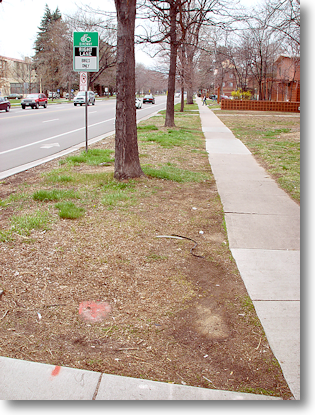
The red spray paint on the sidewalk is your clue that this area is due for a change in the near future. Once again, note the different colored blocks of concrete revealing the undisturbed areas.
We talked a bit earlier about sidewalk construction, but there are many more opportunities to take advantage of newly exposed ground in construction areas. One of the best things you can stumble upon is a land owner doing landscaping on the parkway area. A lot of the time this ground is so old and depleted they choose to scrape it off to plant new grass, install sprinklers, and put in new shrubs or trees. This is your chance to get great access to those old coins just below the surface. Drive the older neighborhoods frequently. Choose different routes as you cross town. Quite often the first steps in doing any digging for these landscaping projects is having the utility location service come out to mark the areas that contain buried cables and pipes. These spray-painted marks are easy to spot and are your clue to watch this area closely. The presence of city workers and survey equipment is good reason to pay attention to an area more closely as well.
I usually have a city street map with me that I mark on with a highlighter. This makes it easier to remember the exact location for a future visual check. You can create your own opportunities by being vigilant with your inspections of these potential hunt areas. Hunt them as they are, but make sure to return when the excavation begins. A few inches of dirt or sod off the surface can make all the difference in the world. If a resident of the property is doing the work, you can increase the likelihood of getting permission to detect with the following tactics...
Look for the job to begin on the weekends, more specifically Saturday mornings. The owners and hired help will be very busy and will see you as an interruption in the job they want to get done if you ask for hunting permission right off the bat. So, approach them at the end of the day in the late afternoon. Here is an approach I've used very successfully...
Explain that you noticed the modifications going on and that it is going to look great when they finish. Have your detector with you and explain to them you enjoy the history of the area and would like to look for old coins in the freshly dug earth. I keep a mercury dime with me for just this occasion. Take the dime out of your pocket and hand it to them and say, "This is what I am looking for." The dime will capture their attention and interest. Turn on your detector and point to the display if you have one. Tell them "This is what tells me when I run across a coin like that one your holding". You have just created some intrigue in what you are doing. More times than not they will tell you to help yourself, followed quickly by the question, "Mind if I watch?" Bingo! Not only do you have the parkway, but the property as well. I don't see this as a con job. I am just helping them feel some of the excitement that I feel for the hunt. Regardless of your approach, always be upfront about what you want to do. I once gained access to several properties by talking to a couple of guys doing some landscape work. It turns out they had a business of flipping houses. So, every new property they bought they would give me a call. They really got a kick out of they stuff I would find. This went on for a year or so, until the market went bad. During that time I made some great finds though. So, on your way to your next hunt look around as you drive through town.
This landscaping project produced a nice Barber Quarter. The owner joined me and found a wheat on his own. I was on my way to the local "hunted out" park when I spotted this activity.
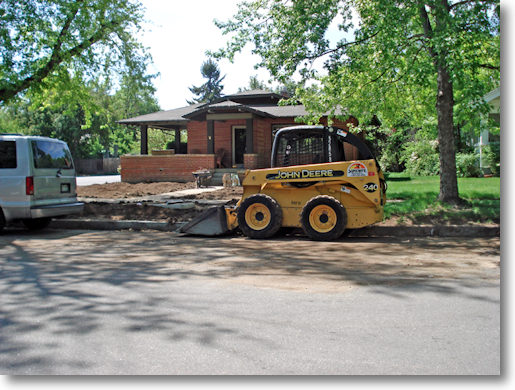
|